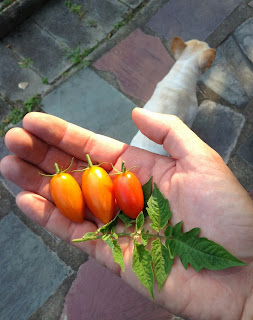Bred in the United States from Angeles City Native and Speckled Roman. We see an interesting divergence at F2. Both varieties maintain a dimpled blossom end but other than that, we have two very different tomatoes.
One is a cherry with a slightly acidic tomato flavor. Very productive, large plants with fairly stiff regular leaf foliage.
The other variety is a paste tomato that has almost the exact same skin and shape as Speckled Roman but is considerably firmer and instead of a protrusion at the blossom end, has a recess. Foliage is also like Speckled Roman in that the plant looks perpetually sickly with wispy, drooping leaves. Flavor is ok but this is a very dry fruit and is more appropriate for cooking as a sauce or salsa.
One is a cherry with a slightly acidic tomato flavor. Very productive, large plants with fairly stiff regular leaf foliage.
The other variety is a paste tomato that has almost the exact same skin and shape as Speckled Roman but is considerably firmer and instead of a protrusion at the blossom end, has a recess. Foliage is also like Speckled Roman in that the plant looks perpetually sickly with wispy, drooping leaves. Flavor is ok but this is a very dry fruit and is more appropriate for cooking as a sauce or salsa.

